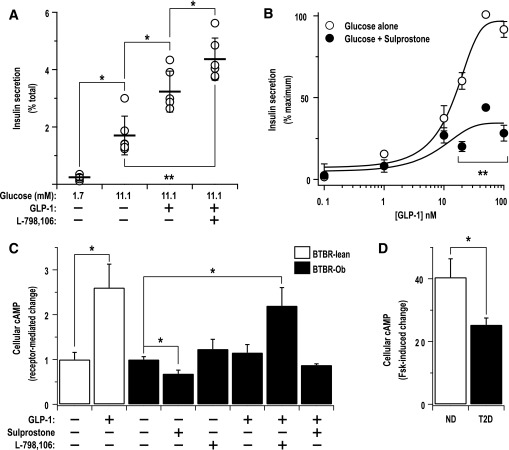FIG. 5.
An EP3 antagonist augments GLP-1–potentiated GSIS and cAMP production from diabetic mouse islets, while an EP3 agonist acts as a noncompetitive inhibitor of GLP-1 signaling. A: Insulin secretion assays were performed with islets isolated from diabetic BTBR mice in the presence or absence of GLP-1 (50 nmol/L) with or without L-798106 (20 μmol/L). Data were compared by paired t test (n = 6; *P < 0.05; **P < 10−4). B: Insulin secretion assays were performed with 11.1 mmol/L glucose and various doses of GLP-1 in the presence or absence of 1 nmol/L sulprostone, an EP3-specific agonist. Each experimental dataset was normalized to the effect of glucose alone with or without sulprostone as 0% and the top plateau for the GLP-1 dose response as 100%. The combined experimental datasets were fit to a sigmoid dose response equation. The EC50s of the two curves are similar (15 nmol/L for glucose vs. 10 nmol/L for glucose plus sulprostone) (n = 3; **P < 10−4). C: cAMP production was measured in the presence of 11.1 mmol/L glucose with and without sulprostone (10 nmol/L), GLP-1 (50 nmol/L), L-798106 (10 μmol/L), or a combination of GLP-1 and sulprostone or L-798106. Only the combination of GLP-1 and L-798106 significantly increased cAMP levels in diabetic BTBR islets. Data were compared by paired t test (n = 3; *P < 0.05). D: Forskolin (Fsk)-stimulated cAMP production assays were performed in islets isolated from lean or diabetic BTBR mice, indicating a reduced intrinsic ability of BTBR-Ob islets to stimulate cAMP production. Data were compared by paired t test (n = 3; *P < 0.05).

